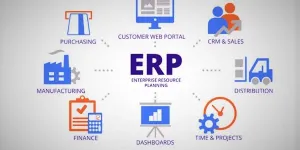In today's rapidly evolving business landscape, managing multiple departments and processes efficiently is crucial for success. Enterprise Resource Planning (ERP) software has emerged as a game-changing solution for businesses of all sizes, offering integrated functionality to streamline operations, enhance collaboration, and drive growth. In this article, we will explore the benefits of implementing ERP software, key features to consider, and how it can transform your organization's productivity and profitability.
Understanding ERP Software:
Enterprise Resource Planning (ERP) software is a centralized system that integrates various core business functions, including finance, human resources, supply chain management, manufacturing, and customer relationship management. By consolidating data and processes, ERP software provides real-time visibility, enabling efficient collaboration and informed decision-making.
The Benefits of ERP Software:
a. Streamlined Operations: ERP software eliminates data silos and promotes seamless information flow across departments. This streamlines processes, reduces manual effort, and minimizes errors. With a holistic view of operations, organizations can optimize workflows, reduce bottlenecks, and enhance overall efficiency.
b. Enhanced Data Accuracy: ERP serves as a single source of truth, ensuring data consistency throughout the organization. By eliminating data duplication and reducing manual entry, ERP minimizes errors and provides accurate, up-to-date information for better decision-making.
c. Improved Collaboration: ERP software facilitates cross-functional collaboration by enabling departments to easily share information and work together in real-time. This improves communication, fosters teamwork, and enhances overall productivity.
d. Data-Driven Decision-Making: ERP systems provide powerful analytics and reporting capabilities, offering valuable insights into business performance, trends, and forecasts. This empowers organizations to make informed, data-driven decisions, identify opportunities, and respond quickly to market changes.
e. Scalability and Adaptability: Erp software solution is designed to scale alongside your business. As your organization grows, the software can accommodate increased data volumes, users, and operational complexities. Additionally, ERP systems can be customized to meet specific industry or business requirements, ensuring a tailored solution.
Key Features of ERP Software:
a. Financial Management: ERP software includes modules for managing financial processes, such as general ledger, accounts payable/receivable, budgeting, and financial reporting. This enables organizations to track expenses, manage cash flow, and generate accurate financial statements.
b. Supply Chain Management: ERP software facilitates end-to-end supply chain visibility, encompassing procurement, inventory management, order processing, and logistics. This helps optimize inventory levels, reduce lead times, and improve overall supply chain efficiency.
c. Human Resource Management: ERP systems offer features for managing employee information, payroll, benefits administration, performance management, and training. This streamlines HR processes, enhances employee productivity, and supports talent management strategies.
d. Manufacturing and Production Planning: ERP software provides modules for managing manufacturing processes, production planning, and scheduling. This enables organizations to optimize production capacity, reduce waste, and improve production efficiency.
e. Customer Relationship Management (CRM): ERP integrates customer data and interactions, allowing organizations to effectively manage customer relationships, sales processes, and marketing campaigns. This supports personalized customer experiences, enhances customer satisfaction, and drives revenue growth.
Implementing ERP Software:
a. Evaluate Your Business Needs: Assess your organization's requirements and goals, considering factors such as size, industry, and specific pain points. Determine the features and functionalities you need from an ERP software solution.
b. Research and Select: Conduct thorough research, compare different ERP software options, and choose a solution that aligns with your business needs, scalability, and budget. Consider factors such as vendor reputation, product features, and customer reviews.
c. Planning and Customization: Develop an implementation plan, including data migration, system configuration, and employee training. Collaborate with the ERP software provider to customize the system to fit your unique business processes.
d. User Training and Change Management: Provide comprehensive training to employees to ensure they understand how to use the ERP software effectively. Implement change management strategies to support employee adoption and engagement.
e. Ongoing Support and Optimization: Establish a support system with the ERP software provider to address any technical issues or questions that arise. Continuously evaluate and optimize the system based on user feedback and evolving business needs.
Conclusion:
Implementing ERP software offers businesses a powerful tool to streamline operations, enhance collaboration, and drive growth. With integrated functionality and real-time visibility, ERP software empowers organizations to optimize processes, make data-driven decisions, and stay competitive in the dynamic business landscape. Embrace the transformative capabilities of ERP software and unlock the full potential of your organization's productivity and profitability.


